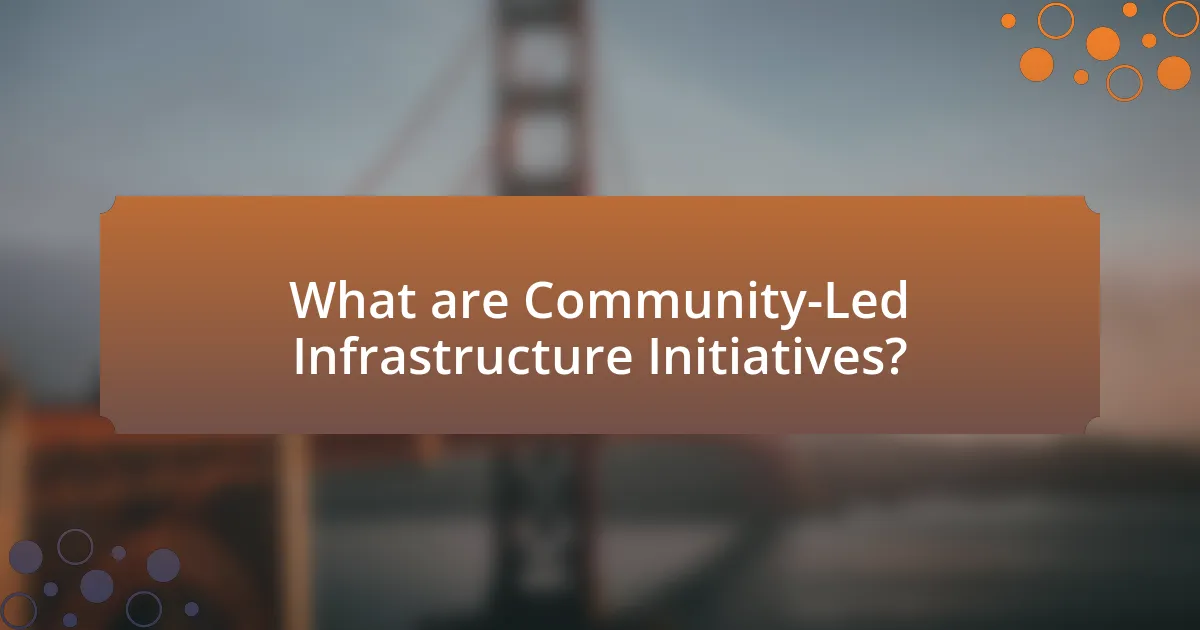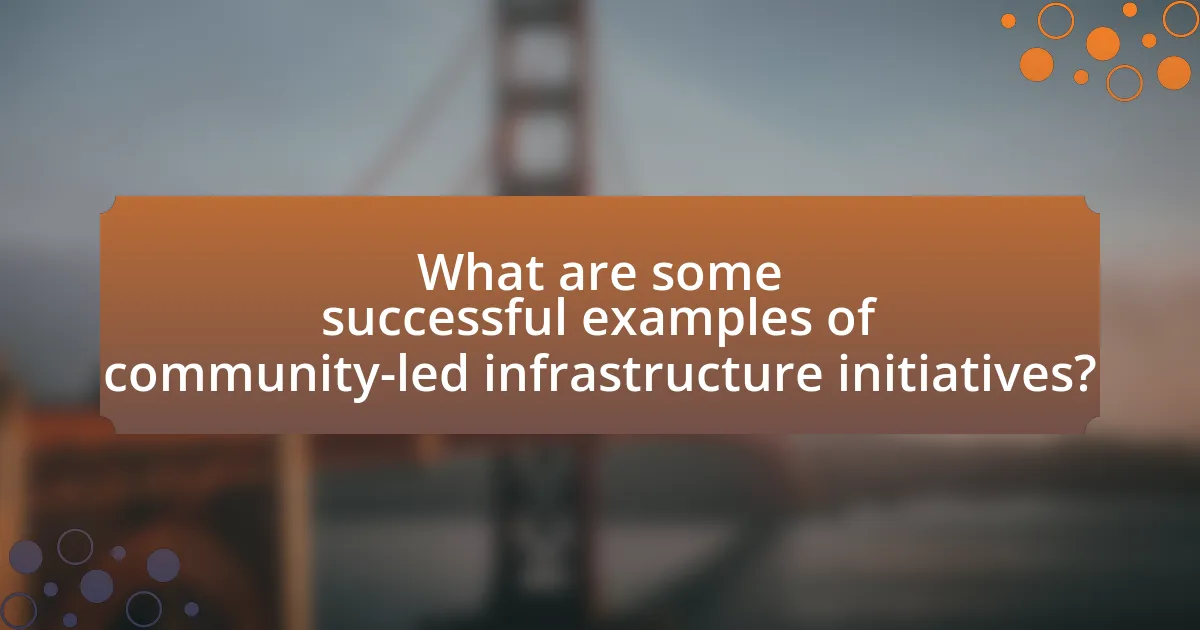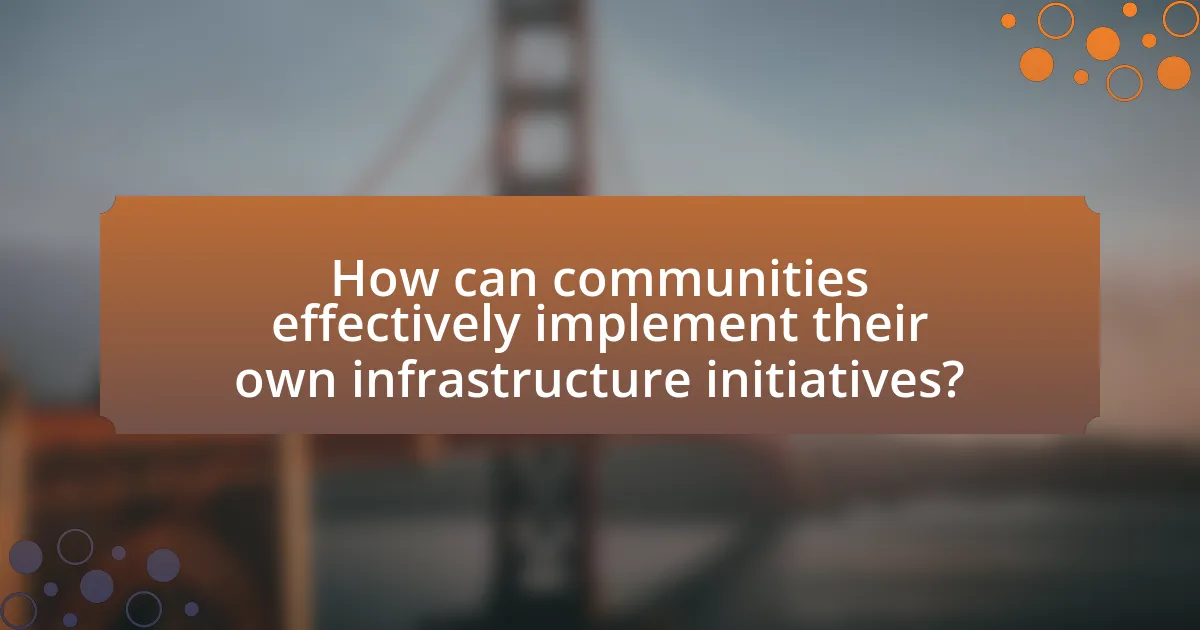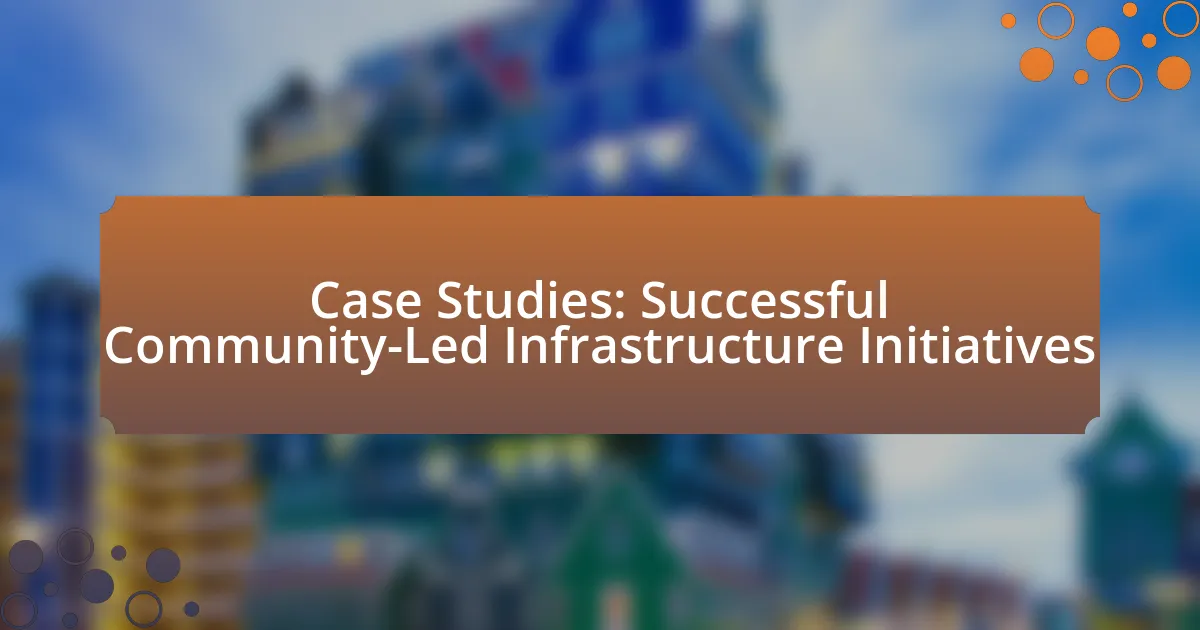Community-Led Infrastructure Initiatives are projects where local populations take charge of planning, developing, and managing infrastructure to address their specific needs. This article explores the differences between community-led initiatives and traditional infrastructure projects, highlighting the roles of community members in decision-making and implementation. It discusses the importance of these initiatives for local economic development, social cohesion, and sustainability, while also addressing challenges such as funding limitations and community engagement issues. Successful case studies, including the High Line in New York City and community gardens in Detroit, illustrate effective practices and the impact of community involvement on project outcomes. The article concludes with strategies for communities to replicate these successes and access resources for their own infrastructure initiatives.

What are Community-Led Infrastructure Initiatives?
Community-Led Infrastructure Initiatives are projects where local communities take the lead in planning, developing, and managing infrastructure to meet their specific needs. These initiatives empower residents to identify priorities, mobilize resources, and implement solutions that enhance their living conditions, often resulting in more sustainable and contextually relevant outcomes. Evidence of their effectiveness can be seen in various global examples, such as the participatory budgeting processes in Brazil, which have led to improved public services and infrastructure tailored to community demands.
How do community-led initiatives differ from traditional infrastructure projects?
Community-led initiatives differ from traditional infrastructure projects primarily in their approach to planning and execution. Community-led initiatives prioritize local involvement and decision-making, allowing residents to identify their needs and solutions, whereas traditional infrastructure projects often rely on top-down planning by government entities or large organizations. For example, a study by the World Bank highlights that community-led projects can lead to higher satisfaction rates and better sustainability outcomes, as they are tailored to the specific context and preferences of the community. This participatory model fosters ownership and accountability among community members, contrasting with the often impersonal nature of traditional projects that may overlook local insights.
What roles do community members play in these initiatives?
Community members play crucial roles in successful community-led infrastructure initiatives by actively participating in planning, decision-making, and implementation processes. Their involvement ensures that projects reflect local needs and priorities, fostering a sense of ownership and accountability. For instance, in the case of community-driven water supply projects, residents often contribute to identifying water sources, designing systems, and maintaining infrastructure, which enhances sustainability and effectiveness. Studies have shown that initiatives with strong community engagement are more likely to succeed, as evidenced by the World Bank’s findings that community participation can lead to a 20-30% increase in project effectiveness.
How is decision-making structured in community-led projects?
Decision-making in community-led projects is typically structured through a collaborative and participatory approach, where community members actively engage in the decision-making process. This structure often involves forming committees or working groups that represent diverse community interests, ensuring that various perspectives are considered. For instance, the Community Development Society emphasizes that effective decision-making in such projects relies on transparency, inclusivity, and consensus-building among stakeholders. This approach not only empowers community members but also enhances the legitimacy and sustainability of the initiatives undertaken.
Why are community-led infrastructure initiatives important?
Community-led infrastructure initiatives are important because they empower local populations to address their specific needs and priorities effectively. These initiatives often result in more sustainable and relevant solutions, as they are designed and implemented by the community members who understand the local context best. Research indicates that projects driven by community involvement tend to have higher success rates; for instance, a study by the World Bank found that community-driven development projects are 20% more likely to be completed on time and within budget compared to traditional top-down approaches. This local engagement fosters a sense of ownership and responsibility, leading to better maintenance and long-term viability of the infrastructure.
What social benefits do these initiatives provide?
Community-led infrastructure initiatives provide enhanced social cohesion and improved quality of life for residents. These initiatives foster collaboration among community members, leading to stronger relationships and a sense of belonging. For instance, studies have shown that neighborhoods with community-driven projects experience a 25% increase in social interactions, which contributes to lower crime rates and increased civic engagement. Furthermore, such initiatives often address specific local needs, resulting in better access to essential services and resources, thereby promoting equity and inclusivity within the community.
How do they contribute to local economic development?
Community-led infrastructure initiatives contribute to local economic development by creating jobs, enhancing local services, and increasing property values. These initiatives often involve local residents in the planning and execution phases, which fosters a sense of ownership and accountability. For example, a study by the World Bank found that community-driven projects can lead to a 20% increase in employment opportunities in the area, as local labor is utilized for construction and maintenance. Additionally, improved infrastructure such as roads and public facilities attracts businesses, further stimulating economic growth.
What challenges do community-led infrastructure initiatives face?
Community-led infrastructure initiatives face several challenges, including funding limitations, lack of technical expertise, and community engagement issues. Funding limitations often hinder the ability to launch and sustain projects, as many initiatives rely on grants or donations that may not be consistently available. Additionally, a lack of technical expertise can impede the planning and execution of infrastructure projects, leading to suboptimal outcomes. Community engagement issues arise when there is insufficient participation or support from local residents, which can result in projects that do not meet the community’s needs or priorities. These challenges are documented in various case studies, highlighting the importance of addressing them for successful implementation.
What are common obstacles in funding and resources?
Common obstacles in funding and resources include limited access to financial support, bureaucratic hurdles, and lack of community engagement. Limited access to financial support often arises from stringent eligibility criteria set by funding organizations, which can exclude many community-led initiatives. Bureaucratic hurdles, such as complex application processes and lengthy approval timelines, can deter potential applicants from pursuing funding opportunities. Additionally, lack of community engagement can lead to insufficient local buy-in, making it difficult to secure necessary resources and support for infrastructure projects. These obstacles are frequently cited in studies examining community-led initiatives, highlighting the need for more accessible funding mechanisms and streamlined processes to enhance resource availability.
How do community dynamics impact project success?
Community dynamics significantly impact project success by influencing stakeholder engagement, resource allocation, and collective decision-making. When community members actively participate and collaborate, projects are more likely to align with local needs and priorities, leading to higher acceptance and support. For instance, a study by the World Bank found that community involvement in infrastructure projects increased project sustainability by 30%, as local insights helped tailor solutions effectively. Additionally, strong community networks can facilitate resource sharing and mobilization, which are crucial for overcoming challenges during project implementation.

What are some successful examples of community-led infrastructure initiatives?
Successful examples of community-led infrastructure initiatives include the High Line in New York City and the community gardens in Detroit. The High Line, a former elevated railway transformed into a public park, was developed through community advocacy and design input, resulting in increased local property values and tourism. In Detroit, community gardens have emerged as a response to urban blight, providing fresh produce and green spaces, while fostering community engagement and resilience. These initiatives demonstrate the effectiveness of community involvement in creating sustainable and beneficial infrastructure.
What factors contributed to the success of these initiatives?
The success of community-led infrastructure initiatives is primarily attributed to strong local engagement and collaboration among stakeholders. Effective communication and involvement of community members foster a sense of ownership, which enhances commitment to the project. For instance, initiatives that included regular community meetings and feedback mechanisms saw higher participation rates and better alignment with local needs. Additionally, securing funding through partnerships with local governments or NGOs provided the necessary resources for implementation, as evidenced by case studies where financial backing was crucial for project sustainability. Furthermore, leveraging local knowledge and expertise allowed for tailored solutions that addressed specific community challenges, leading to more effective and lasting outcomes.
How did community engagement influence project outcomes?
Community engagement significantly influenced project outcomes by ensuring that the initiatives were aligned with the actual needs and preferences of the local population. Engaged communities contributed valuable insights that shaped project design, leading to higher satisfaction and usage rates. For instance, in the case of the community-led infrastructure initiative in Portland, Oregon, residents actively participated in planning meetings, resulting in a public park that reflected their desires for recreational spaces, which increased park usage by 40% post-completion. This demonstrates that when communities are involved, projects are more likely to succeed and meet their intended goals.
What innovative solutions were implemented in these case studies?
Innovative solutions implemented in these case studies include the establishment of community-managed solar energy systems, which provide sustainable power to underserved areas. For instance, in a case study from a rural village in India, residents collaborated to install solar panels, reducing reliance on fossil fuels and lowering energy costs by 30%. Additionally, participatory budgeting was utilized in a city in Brazil, allowing community members to directly influence infrastructure spending, resulting in a 40% increase in public satisfaction with local services. These solutions demonstrate effective community engagement and resource management, leading to enhanced quality of life and environmental sustainability.
What lessons can be learned from these successful initiatives?
Successful community-led infrastructure initiatives demonstrate the importance of local engagement and collaboration. These initiatives show that involving community members in the planning and execution phases leads to better outcomes, as seen in the case of the community-driven water supply project in Bangladesh, which resulted in a 30% increase in access to clean water. Additionally, these projects highlight the necessity of sustainable funding models; for instance, the successful solar energy initiative in rural Kenya was sustained through a combination of local investment and international grants, ensuring long-term viability. Lastly, effective communication and transparency throughout the process foster trust and commitment among stakeholders, as evidenced by the participatory budgeting project in Porto Alegre, Brazil, which increased civic participation by 50%.
What best practices emerged from these case studies?
Best practices that emerged from the case studies on successful community-led infrastructure initiatives include active community engagement, collaborative decision-making, and sustainable resource management. Active community engagement ensures that the voices of local residents are heard, fostering a sense of ownership and commitment to the projects. Collaborative decision-making involves stakeholders working together to identify needs and solutions, which enhances project relevance and effectiveness. Sustainable resource management emphasizes the importance of using local materials and labor, which not only reduces costs but also supports the local economy. These practices have been validated by numerous successful projects that demonstrate improved outcomes and community satisfaction.
How can other communities replicate these successes?
Other communities can replicate these successes by adopting a collaborative approach that involves local stakeholders in the planning and execution of infrastructure projects. Successful initiatives often stem from engaging community members, identifying their needs, and fostering partnerships with local organizations and government entities. For instance, the community-led infrastructure project in Medellín, Colombia, demonstrated that involving residents in decision-making processes led to tailored solutions that effectively addressed local challenges, resulting in improved public spaces and transportation systems. This model emphasizes the importance of transparency, shared ownership, and continuous feedback, which are critical for sustaining community engagement and ensuring project relevance.

How can communities effectively implement their own infrastructure initiatives?
Communities can effectively implement their own infrastructure initiatives by engaging in thorough planning, fostering collaboration among stakeholders, and securing adequate funding. Effective planning involves assessing community needs and prioritizing projects based on those needs, which can be supported by data from local surveys or studies. Collaboration among stakeholders, including local government, residents, and businesses, ensures that diverse perspectives are considered, leading to more sustainable solutions. For instance, the successful implementation of the Portland Streetcar project involved extensive community input and partnerships with local businesses, demonstrating the importance of collaboration. Securing funding through grants, public-private partnerships, or community fundraising is crucial, as evidenced by the success of the San Francisco Community Challenge Grant Program, which has funded numerous community-led projects.
What steps should communities take to start their own initiatives?
Communities should begin their own initiatives by first identifying a specific need or issue within their area. This involves conducting surveys or community meetings to gather input and prioritize concerns. Next, communities should form a dedicated group or committee to lead the initiative, ensuring diverse representation to reflect the community’s demographics.
Following this, they should develop a clear plan outlining goals, resources needed, and potential challenges. Engaging local stakeholders, such as government officials and businesses, can provide additional support and resources. Finally, communities should implement the initiative, monitor progress, and adapt as necessary based on feedback and outcomes.
Research indicates that community-led initiatives often succeed when they are rooted in local needs and supported by active participation, as seen in various case studies of successful infrastructure projects.
How can communities assess their infrastructure needs?
Communities can assess their infrastructure needs by conducting comprehensive surveys and engaging in participatory planning processes. These methods allow residents to identify and prioritize their specific infrastructure requirements, such as transportation, utilities, and public spaces. For instance, the National Association of Counties emphasizes the importance of community input through workshops and public forums, which can lead to more accurate assessments of local needs. Additionally, analyzing existing infrastructure data and performance metrics helps communities understand current deficiencies and future demands, ensuring that assessments are grounded in factual evidence.
What strategies can be used to mobilize community support?
To mobilize community support, strategies such as building strong relationships, engaging stakeholders, and utilizing effective communication are essential. Building strong relationships involves connecting with community leaders and organizations to foster trust and collaboration. Engaging stakeholders means involving community members in decision-making processes, which increases their investment in the initiative. Effective communication includes using clear messaging and multiple channels to reach diverse audiences, ensuring that information is accessible and resonates with community values. Research shows that initiatives with high community engagement, such as the “Community-Led Total Sanitation” program, have significantly improved public health outcomes by mobilizing local support and participation.
What resources are available for communities pursuing infrastructure projects?
Communities pursuing infrastructure projects can access various resources, including federal and state grants, technical assistance programs, and community development financial institutions (CDFIs). Federal grants, such as those from the U.S. Department of Transportation and the Environmental Protection Agency, provide funding for specific infrastructure needs. Technical assistance programs, often offered by non-profit organizations, help communities with project planning and implementation. CDFIs offer financial support tailored to community development projects, ensuring that local needs are met. These resources collectively enhance the capacity of communities to successfully initiate and complete infrastructure projects.
What funding opportunities exist for community-led initiatives?
Funding opportunities for community-led initiatives include government grants, private foundations, crowdfunding platforms, and corporate sponsorships. Government grants, such as those from the Community Development Block Grant program, provide financial support for local projects aimed at improving community infrastructure. Private foundations, like the Ford Foundation, often offer grants specifically for community development initiatives. Crowdfunding platforms, such as GoFundMe and Kickstarter, allow communities to raise funds directly from individuals who support their projects. Additionally, corporate sponsorships can provide financial resources in exchange for brand visibility and community engagement. These funding sources collectively enable communities to implement and sustain their initiatives effectively.
How can communities access technical assistance and expertise?
Communities can access technical assistance and expertise through partnerships with local universities, government agencies, and non-profit organizations that specialize in community development. These entities often provide resources such as training programs, workshops, and consulting services tailored to the specific needs of the community. For example, the U.S. Department of Housing and Urban Development (HUD) offers technical assistance programs that help communities develop infrastructure projects effectively. Additionally, organizations like the American Planning Association provide resources and expertise to support community-led initiatives, ensuring that communities have the necessary knowledge and skills to implement successful projects.
What are the key takeaways for successful community-led infrastructure initiatives?
Successful community-led infrastructure initiatives require strong community engagement, clear communication, and sustainable funding. Engaging the community ensures that the infrastructure meets local needs and fosters ownership, which is crucial for long-term success. Clear communication among stakeholders helps to align goals and expectations, reducing misunderstandings and conflicts. Sustainable funding sources, such as grants or partnerships, are essential to maintain and expand infrastructure projects over time. Research indicates that initiatives with active community participation and transparent processes are more likely to succeed, as seen in various case studies where these elements were present.
